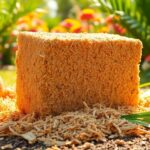Bokashi composting explained
Bokashi composting is gaining popularity as an innovative solution for urban dwellers looking to manage food waste more effectively. This method enables individuals to compost in limited spaces, transforming food scraps into nutrient-rich soil amendments.
Whether you’re a seasoned gardener or a beginner looking to adopt sustainable practices, understanding Bokashi composting can significantly enhance your efforts in reducing waste and improving soil health.
What You Need to Know About Bokashi Composting
Bokashi composting is a unique anaerobic process that was developed by Dr. Teuro Higa in the 1980s. Unlike traditional composting, which relies on aerobic decomposition, Bokashi relies on fermentation. This method can handle a wider variety of organic materials, including meat and dairy, which are typically not recommended in standard composting methods.
By using a Bokashi composting bin and specific inoculants, you can ferment food waste rather than decompose it. This process preserves valuable nutrients, minimizes greenhouse gas emissions, and produces a nutrient-rich “bokashi tea” that can be used to enhance soil health.
It’s essential to understand the distinction between Bokashi composting and other composting techniques. This method is especially suited for urban environments, where space is limited and the type of waste generated can vary significantly.
How to Get Started With Bokashi Composting?
Starting with Bokashi composting is straightforward. First, you’ll need to gather the necessary materials, including a Bokashi composting kit and a suitable bin.
- Choose a Bokashi bin: These are specially designed to create an anaerobic environment.
- Purchase Bokashi bran: This is the inoculant that contains the necessary microbes for fermentation.
- Layer your food scraps: Alternate layers of food waste and Bokashi bran in your bin.
- Seal the bin: Ensure it’s tightly closed to create the required anaerobic conditions.
- Wait for fermentation: After about two weeks, the food waste will ferment.
Once the fermentation process is complete, you can bury the contents in your garden or mix them with soil. This method not only reduces waste but also enriches your garden with nutrients.
What Is Bokashi Composting?
Bokashi composting is an anaerobic fermentation method that transforms food waste into a valuable soil amendment. It utilizes beneficial microorganisms to ferment organic materials, retaining nutrients and reducing waste considerably.
Unlike traditional composting, Bokashi allows for the inclusion of a broad range of organic materials, including protein-rich waste like meat and dairy. This makes it a versatile choice for many households.
Another key aspect of Bokashi composting is the production of Bokashi tea, a nutrient-rich liquid that can be diluted with water and used as a fertilizer for plants. This tea provides an excellent boost to plant growth and soil health.
How Does Bokashi Composting Work?
The Bokashi process begins with layering food scraps and Bokashi bran in a sealed bin. The bran introduces beneficial microbes that initiate fermentation. This anaerobic environment allows for a rapid breakdown of organic matter.
Over the course of about two weeks, the microorganisms work to ferment the food waste. This process preserves nutrients and minimizes the production of harmful greenhouse gases, making it an environmentally friendly option.
Once the fermentation is completed, the material transforms into pre-compost, which can then be buried in soil or added to a traditional compost pile to continue the decomposition process.
What Are the Benefits of Bokashi Composting?
Bokashi composting offers numerous benefits, making it an attractive choice for many. Here are some of the key advantages:
- Versatility: You can compost a wide variety of food scraps, including meat and dairy.
- Space-efficient: Ideal for urban settings where space is a concern.
- Nutrient retention: The fermentation process retains valuable nutrients that can enhance soil quality.
- Reduced odors: Compared to traditional composting, Bokashi minimizes unpleasant smells.
- Quick process: Fermentation occurs rapidly, allowing for quicker turnover of compost.
These benefits make Bokashi composting a sustainable option for anyone seeking to reduce their environmental footprint while improving their gardening activities.
Bokashi Composting vs. Traditional Composting: Which Is Better?
When comparing Bokashi composting to traditional composting, there are several factors to consider. Each method has its strengths and weaknesses.
Traditional composting relies on aerobic decomposition, which requires more space and specific conditions to be effective. It typically requires regular turning and maintenance to aerate the pile.
On the other hand, Bokashi composting is simpler to manage and ideal for smaller spaces. It allows for a broader range of materials, making it a more versatile option for urban dwellers.
Ultimately, the choice between these two methods will depend on individual circumstances, including available space, type of waste generated, and personal composting goals.
Troubleshooting Bokashi Composting Issues: Common Problems and Solutions
Like any composting method, Bokashi composting can face challenges. Here are some common issues and potential solutions:
- Odor problems: If your bin smells bad, it may be due to excess moisture or not enough Bokashi bran. Check the moisture level and add more bran if necessary.
- Slow fermentation: Ensure your bin is sealed properly, as air exposure can hinder the fermentation process.
- Unwanted pests: Keep your bin in a cool, dry place and ensure it’s securely closed to deter pests.
- Inconsistent results: Maintain a consistent layering process and avoid adding too many liquid items that can disrupt the balance.
Addressing these common problems can help ensure a successful Bokashi composting experience.
Ways to Use Bokashi Compost in Your Garden
Once your Bokashi compost has fermented, there are various ways to utilize it in your garden:
- Burying: Bury the pre-compost in your garden beds, where it will continue to decompose and enrich the soil.
- Mixing with soil: Combine Bokashi compost with potting soil for potted plants or raised beds.
- Creating compost tea: Steep the fermented material in water for a nutrient-rich liquid fertilizer.
Using Bokashi compost not only enhances soil health but also encourages microbial activity, further supporting plant growth. By implementing these practices, you can maximize the benefits of your Bokashi composting efforts.
For a more in-depth understanding of this innovative composting technique, check out this informative video.




